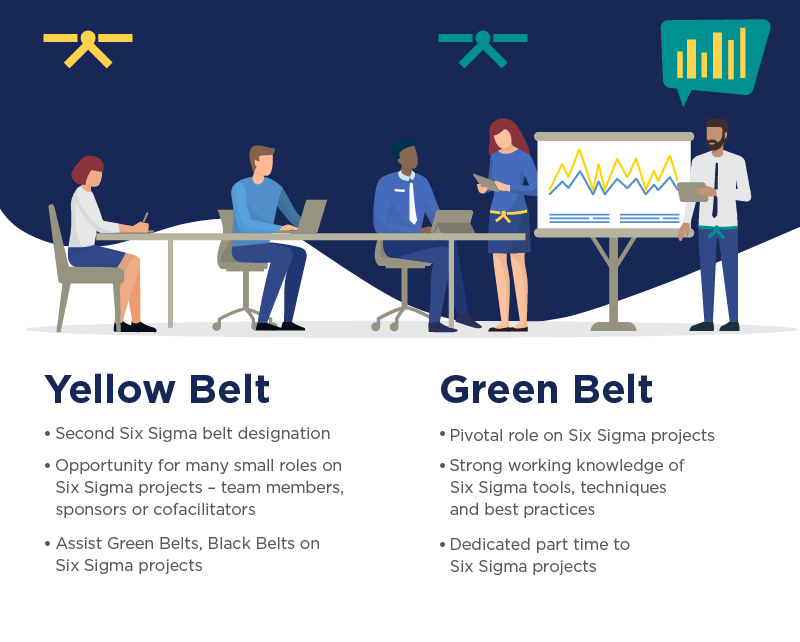Six Sigma Belt Rankings

Last Updated March 8, 2024
In general, organizations continually aim to maximize resources to their fullest extent, and in turn, streamline processes to improve quality, efficiency and performance. Over the years, many companies have accomplished this through Six Sigma, a process improvement methodology designed to increase process efficiency through a disciplined, data-driven approach. The primary goal of Six Sigma is to streamline business processes by eliminating defects, variations and wastes in a product or service.
Six Sigma Belt Designations
Six Sigma uses problem solving tools, advanced analytics and statistics methodology to improve quality. While these tools and methods are important to the Six Sigma process, the success of a Six Sigma project ultimately depends on the people involved. If you’re thinking about earning a Six Sigma professional certification and want to learn more about how Six Sigma works, a great place to start is by learning about Six Sigma’s belt ranking system.
The belt levels in Six Sigma are similar to the belt rankings awarded in the martial arts. Belts are titles awarded to practitioners based on their level of skill, experience, knowledge and training in Six Sigma principles. To understand how employees’ strengths and skills can be applied in a Six Sigma project, it is helpful to understand what each belt signifies.
Six Sigma White Belt Role

This is the beginner’s belt of Six Sigma. Earning a Six Sigma White Belt is ideal for professionals who want to begin their Six Sigma journey by learning more about the methodology and how it can impact their organization. White Belts can range from front-line workers to corporate executives. This training provides professionals with a basic working knowledge of the Six Sigma methodology and its vocabulary.
White Belts generally assist problem-solving teams within their organization, while also helping instill Six Sigma culture into the workplace and encouraging other employees to practice it. For example, a Six Sigma White Belt may lend an extra pair of hands and eyes to help collect data and offer insight into how certain processes are working.
Role of a Six Sigma Yellow Belt
Unlike White Belts, Yellow Belts already have a basic understanding of Six Sigma principles and common terminology. They are not experts in Six Sigma, but they have been introduced to the jargon and tools frequently used in the approach.
Yellow Belts often work under a project leader who is at least Green Belt or Black Belt certified. At the start of a project, Yellow Belts are typically tasked with creating process maps and contributing to data gathering. Yellow Belts practice Six Sigma on a part-time basis, but what they may lack in expertise, they typically make up for in local process knowledge.
Organizations can help ensure that Six Sigma is understood and implemented at all levels of a company by offering White or Yellow Belt training to employees. Professionals interested in more in-depth training and tools should consider higher Six Sigma designations.

Six Sigma Green Belt Responsibilities
Green Belts are at the heart of the action. Most of the work completed by Six Sigma project teams is performed by Green Belts. They typically dedicate between 25% and 50% of their working time to Six Sigma projects. At this stage, Green Belts are considered experts in Six Sigma philosophies and principles, but perhaps most importantly, they are regarded as experts in the process that they are improving.
Green Belts play an important role identifying and implementing improvements throughout the organization by helping their project teams gather and analyze data. This helps minimize variation in order to produce higher quality goods and services.
Successful Green Belts typically possess strong analytical skills and are able to communicate at all levels of an organization. This level of training is often applicable for employees working in a quality assurance role or a mid-to-upper level management role, and can help act as a stepping-stone to increased responsibilities.
Six Sigma Black Belt

Black Belts serve as leaders and are responsible for managing multiple teams made up of Green, Yellow and White Belts. Black Belts practice Six Sigma on a full-time basis. Because of the expertise required, candidates should obtain Six Sigma Green Belt training before pursuing their Black Belt.
Black Belts should possess a mastery of process improvement and statistical analysis techniques. They should have strong people skills and act as effective leaders and mentors for project team members. Black Belts are also able to teach Six Sigma principles to project teams and leadership when needed. Consistency is key when it comes to the Black Belt role as holders must use their time wisely, and be good decision makers to ensure their project teams stay on task and meet deadlines.
While requirements can be more rigorous for a Black Belt, the certification prepares professionals to be experts in Six Sigma and leaves them just one step away from achieving the highest of all Six Sigma belts, the Master Black Belt.
What is a Master Black Belt?

The title of Master Black Belt indicates an employee has completed extensive training and testing, has mastered the concepts of Six Sigma and practices their craft with exceptional discipline, focus and skill. Master Black Belts serve as mentors to Black and Green Belts as well as other team members, and are often tasked with communicating with senior executives and identifying potential Six Sigma projects.
Master Black Belts generally do not function as a full-time member on any one particular team, but rather, serve as an internal consultant for multiple teams and help them overcome technical obstacles and answer procedural questions. This allows them to see the big picture of the organization’s quality improvement efforts and enables them to understand and help influence the company’s Six Sigma efforts.
The strength of a quality improvement team lies not only in its understanding of the concepts of Six Sigma, but also in the skills and confidence of its team members. Therefore, Master Black Belts should have the interpersonal skills necessary to identify and help team members recognize areas for improvement. Excellent communication skills are a necessity to provide team members with the advice and counsel they need to enhance their performance.
Six Sigma often uses tools and data-driven decisions to solve problems, but project success is determined by the people who manage and carry out the projects. Understanding the duties and requirements of each Six Sigma belt level can clarify the roles of each stage and help determine which belt is right for you.





